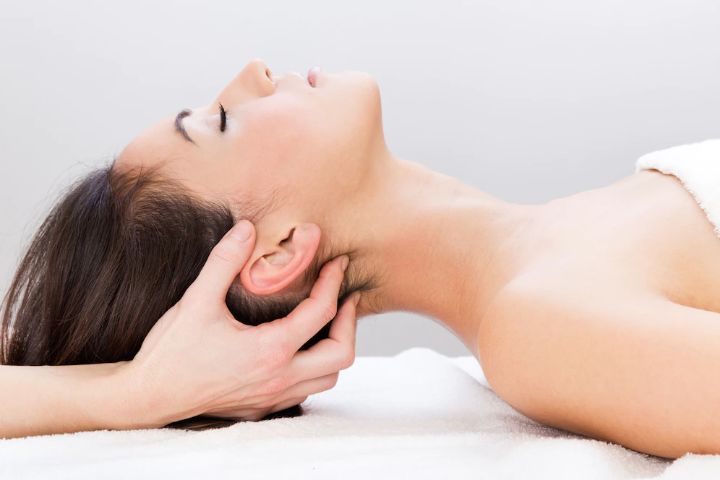Neck arm pain can be debilitating and affects individuals of all ages and lifestyles. Whether caused by injury or stress, the pain and discomfort associated with this condition can greatly impact daily activities. In this section, we will explore the causes, related symptoms, and treatment options for neck arm pain, providing valuable insights into how individuals can effectively manage and alleviate their discomfort.
If you are experiencing neck arm pain, understanding the underlying causes is the first step towards recovery. In the next section, we will delve deeper into the various contributing factors that can lead to this condition and provide guidance on the most appropriate treatment approaches.

Photo Credit: diana_grytsku
Neck arm pain can be debilitating and affects the neck, shoulders, arms, and hands. This condition can be caused by a variety of factors, including muscle strain, nerve compression, and structural abnormalities. Understanding the root causes of neck arm pain is crucial for identifying the appropriate treatment approaches.
Other contributing factors to neck-arm pain include poor posture, emotional stress, and degenerative conditions such as osteoarthritis.
Diagnosing neck arm pain typically involves a physical examination, medical history review, and diagnostic tests such as X-rays, CT scans, or MRIs. These tests can help identify the root cause of the pain and determine the appropriate treatment approach.

Photo Credit: nensuria
Treatment for neck arm pain may involve a combination of medication, physical therapy, and lifestyle modifications. Depending on the severity of the condition, surgical intervention may also be necessary. By working with a healthcare professional, individuals can develop a personalized treatment plan that addresses their specific needs and promotes healing.
Neck arm pain can manifest in a variety of ways, and individuals may experience a range of symptoms. Some common symptoms of neck arm pain include:
If you experience any of these symptoms, it is important to consult a healthcare professional for an accurate diagnosis and appropriate treatment.
Diagnosing neck arm pain can be challenging, as several underlying factors can contribute to this condition. Healthcare professionals may conduct a physical examination to assess range of motion, muscle strength, and reflexes. Imaging tests, such as X-rays or MRIs, may also be used to determine the root of the pain.
Once diagnosed, several treatment options may be recommended depending on the severity and cause of the pain. Over-the-counter pain medications, such as acetaminophen or ibuprofen, may be prescribed to alleviate discomfort and reduce inflammation. In some cases, stronger prescription medications may be required.

Photo Credit: wayhomestudio
Physical therapy is another effective treatment option for muscle strains and nerve compressions. Strengthening and stretching exercises can improve mobility and provide long-term pain relief.
Preventing neck arm pain involves adopting healthy habits and making lifestyle modifications. Here are some tips for preventing future pain episodes:
If you are experiencing neck arm pain, several home remedies can help alleviate discomfort:

Photo Credit: drobotdean
Exercise is an effective way to relieve neck arm pain and improve mobility. It can help promote circulation, reduce stiffness, and strengthen muscles that support the neck and arms. Here are some exercises that you can do at home:
Neck stretches can help relieve tension and reduce pain in the neck and shoulders. Here’s how to do it:
The shoulder blade squeeze can help strengthen the muscles that support the neck and improve posture. Here’s how to do it:
Arm raises can help strengthen the muscles in your arms and shoulders. Here’s how to do it:
These exercises can be done daily to help alleviate neck arm pain and prevent future episodes. However, it’s important to consult with a healthcare professional before starting any exercise routine, especially if you have a history of neck or arm injuries.
Neck pain radiating down the arm is often due to cervical radiculopathy, where a nerve root in the neck is irritated or compressed. This could be due to a herniated disc, spinal stenosis, or degenerative disc disease.
Yes, neck problems can lead to arm pain. Nerve compression in the cervical spine can cause symptoms to radiate along the nerve’s pathway into the arm, leading to pain, numbness, tingling, or weakness in the arm.
Seek immediate medical attention for neck and arm pain if you experience severe pain, symptoms that rapidly worsen, difficulty walking, loss of bladder or bowel control, severe headaches, or if the pain follows a traumatic injury like a car accident.
Pinched nerve relief can include rest, avoiding activities that exacerbate the pain, over-the-counter pain relievers, physical therapy exercises, and in some cases, corticosteroid injections or surgery. A healthcare provider should guide treatment decisions.